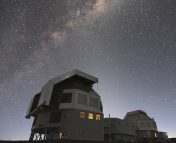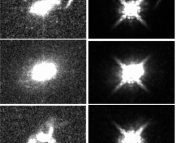Title: Black hole mass estimation for active galactic nuclei from a new angle
Authors: Dalya Baron & Brice Ménard
First Author’s Institution: School of Physics and Astronomy, Tel-Aviv University
Status: To be submitted to MNRAS, open access on Arxiv
One of the most infamous solutions to Einstein’s General Relativity, black holes have been realized in the modern era as a fundamental aspect of our Universe. It is now widely believed that a supermassive black hole (SMBH) resides in the center of nearly every galaxy. What’s more is that over the past two decades, evidence has been building which suggests the lives and deaths of galaxies are dictated in part by their SMBH. This may seem obvious, but SMBHs are incredibly tiny compared to the vastness of a galaxy. To put this into perspective in terms of relative size, it is as if a single atom interferes with your balance as you take a morning jog!
A Brief History of Active Galactic Nuclei
Early observations of galaxies revealed a population with intensely bright central regions called Active Galactic Nuclei (AGN). When measured with spectroscopy, the emission line features from the AGN are bizarre. A set of extremely broad lines are thought to be Doppler broadened due to fast-moving gas clouds near the SMBH, and a set of narrow lines from slower moving photo-ionized clouds further out. Hence, these regions are named the Broad Line Region (BLR) and Narrow Line Region (NLR), respectively.
AGN galaxies seen face-on are Type I, from which we can measure both BLR and NLR emission. The mass of the SMBH can then be readily estimated from velocity distribution associated with the BLR emission line width, in addition to the host galaxy properties calculated by carefully subtracting the AGN light. Active galaxies seen edge-on are Type II, and due to a torus of dust and gas around the SMBH region, we cannot directly observe the BLR. Although measurements of the host galaxy are viable, this obscuration makes SMBH masses very difficult to estimate.
These measurements are important because it appears that the mass of the SMBH scales with the stellar velocities and mass of the much larger galaxy bulge, made up of old red stars. Despite this strong indication of co-evolution between tiny SMBHs and their immense host galaxies, the cause of this relationship remains unclear. The fact that we can only measure a given AGN galaxy along one viewing angle has complicated attempts to understand SMBH and host galaxy properties in a consistent way.
Looking for the Pattern with the Sequencer
The authors of today’s astrobite demonstrate a powerful new way to estimate the masses of SMBHs in Type II AGN. By exploiting a previously unknown relationship between the BLR and the NLR emission lines, they obtain SMBH masses for systems which before now only had measurements of galaxy bulge properties.

Figure 1. The resulting sequence of Type I AGN emission line spectra (left) organized by common line profile. The width of the broad Hα component (green box) is found to scale linearly with the flux ratio of the narrow O[III] and Hβ components (green box; right). See Figures 1 & 3 of the paper.
The approach necessitated the development of the Sequencer, an algorithm to organize spectra of AGN by the similarity in their emission line features. In brief, the algorithm attempts to order the spectra by their aggregate spectral features as shown in Figure 1.
They began by considering a large sample of Type I AGN galaxies for which a spectrum has been taken of their central region where it is possible to observe both the BLR and NLR simultaneously. Each spectrum is first shifted to account for cosmological redshift. Then the underlying continuum is subtracted and the resulting spectra are normalized so that the emission line features can be compared fairly. The result is a sequence of neighboring spectra driven by the width of the prominent Hα line. This is not entirely surprising: the Hα line is particularly strong in most galaxy emission spectra.
But there is something more astonishing. The average flux of the narrow NLR component of Hα and Hβ systematically decreases as their BLR component broadens. They explore this relationship using the width of broad Hα and the ratio of narrow O[III] to narrow Hβ fluxes. These selections are convenient as neither is sensitive to the flux normalization, and the latter is both insensitive to dust and traditionally used to estimate the ionization strength of the gas in the NLR. As shown in Figure 1, this relationship is for the most part linear. Hence the take-away: the velocity broadening of the BLR can be estimated from the ratio of NLR narrow lines! The slight nonlinearity can be explained by contamination from luminous stars.
With this linear relation in hand, the BLR gas cloud velocities (and hence SMBH mass) can be obtained for Type II AGN by only measuring their narrow O[III]/Hβ fluxes. As shown in Figure 2, the classical relationship between SMBH mass and bulge region mass for Type I AGN (right) holds for this difficult-to-characterize population of Type II AGN (left).

Figure 2. Black hole mass is known to scale with increasing velocity broadening of the host bulge (σ*). The colored points for Type II AGN (left) and Type I AGN (right) from this work agree well with uncolored points from the literature, and greatly increase the statistical certainty of this poorly understood relation. See Figure 6 of the paper.
Implications for Galaxy Evolution
Galaxy evolution has been a story about expanding horizons. Evidence for the physical cause underpinning the relationship between SMBH mass and bulge properties explored here will most likely come from evaluating this relation during times when galaxies were rapidly assembling, during an epoch known as Cosmic Noon. Earlier times too may reveal startlingly different realities from theories currently proposed.
Future speculation aside, the immediate result of this pioneering method is a new probe with which to study Type II AGN. Like a phoenix arisen from the ashes, the previously disregarded population of edge-on active galaxies may now be used to explore the relationship between the properties of the bulge, and the mass of the minuscule but fantastically powerful beast that lies at its center.




